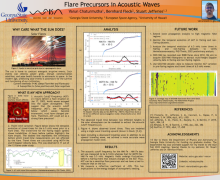Flare Precursor Signatures in Acoustic Waves
Varun
Chaturmutha
Georgia State University
Poster
The field of helioseismology was heralded by the detection of acoustic waves in the solar atmosphere. Acoustic waves, which have traditionally been used to probe the solar interior, can also be used to map the solar atmosphere which is home to solar eruptive events. Predicting such events represents one of the most prominent outstanding questions in heliophysics. In our work, we will employ our recently developed acoustic wave analysis to search for predictive information on solar eruptive events. The analysis involves modeling travel time measurements of waves in the Sun's atmosphere using a plane wave propagation model and estimating atmospheric properties such as acoustic cutoff frequency, radiative cooling time, and sound speed. Measurements by Finsterle et al. (2004) suggest that the acoustic cutoff frequency may experience changes in the hours leading up to the flare from changes in the magnetic field inclination due to the ramp effect. Moreover, the temporal evolution of the travel time measurements of the 6.5 mHz waves by Venkataramanasastry (2022) has shown strong variance in flaring regions when compared to non-flaring regions of similar magnetic field strengths. These results suggest that acoustic waves could carry strong flare precursor signatures. To this end, we will capitalize on the wealth of SDO/HMI data that has recorded 8000+ flares during Solar Cycle 24. By studying the flaring and non-flaring datasets in HMI through our acoustic wave analysis, we will look to verify if measurements of the acoustic wavefield in the Sun's atmosphere provide a flare precursor signal.

Poster PDF
Poster category
Solar and Interplanetary Research and Applications
Meeting homepage